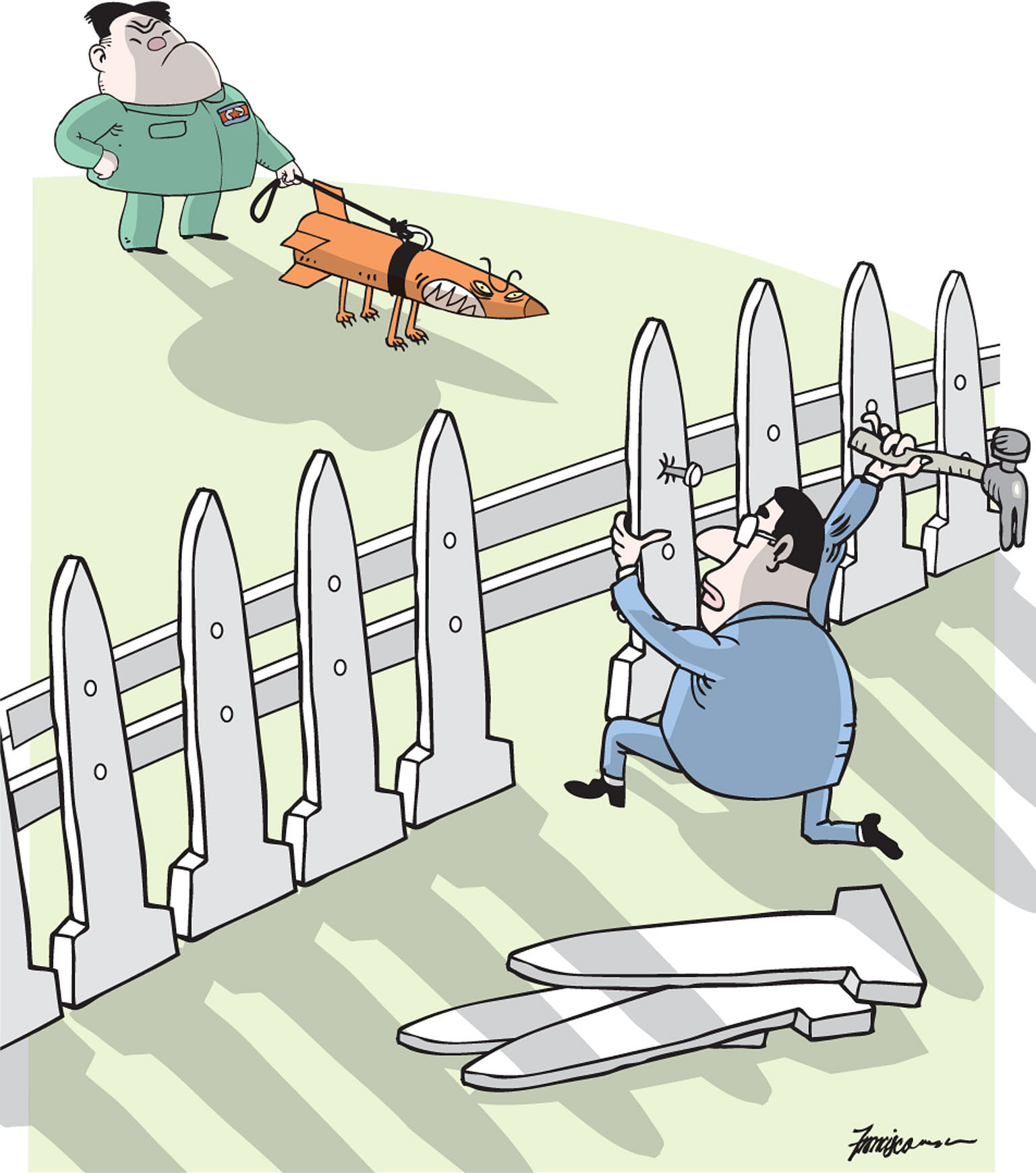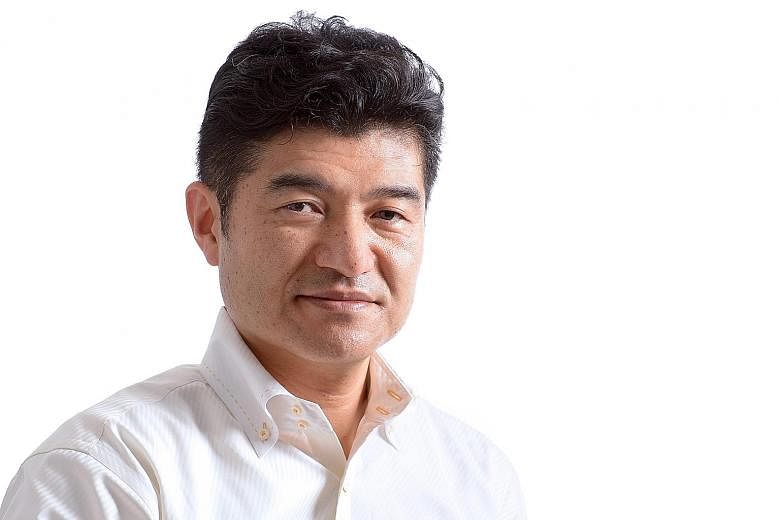In July, the United States and South Korean governments were able to finally come to an agreement on the deployment of Thaad in South Korea.
The agreement to deploy the US Terminal High Altitude Area Defence, an anti-missile defence system, was a telltale sign of how much relations between the North and the South have deteriorated. Some argue that South Korea would never have agreed to Thaad had relations with North Korea not been so terrible.
North Korea's nuclear test on Sept 9, its fifth so far, served as a bold act of defiance following South Korea's agreement with the US to deploy Thaad on the peninsula. North Korea claims that the latest warhead - believed to be twice as powerful as the previous nuclear warhead tested - can be mounted on a missile. North Korea's nuclear and missile programmes have both demonstrated alarming advancements in the past five years. Such unsettling developments serve to highlight the increasing importance of missile defence systems in the region, including Thaad.
Thaad is a US Army ballistic missile defence system capable of intercepting incoming missiles at both high and low altitudes. It is currently scheduled to be deployed to the rural south-eastern county of Seongju by the end of next year. Consisting of a truck-mounted canister launch system carrying 48 missiles married to a powerful radar system designed to detect and track enemy missile launches, Thaad can provide coverage for an area of roughly 430km by 340km, which is significantly larger than what the Patriot PAC-3 system (the type of system currently deployed in South Korea) can provide.

The Thaad battery scheduled to be deployed to Seongju will be able to cover most of South Korea, including the largest US Army and US Air Force bases in the country: Camp Humphreys and Osan Air Base, located roughly 64km south of Seoul. Some estimate that its coverage will extend from the southern part of Seoul down to the southern city of Busan.
LAYERED DEFENCE
Thaad will serve to complement the current assortment of missile defence systems employed in South Korea. Among these are the PAC-3 and PAC-2 systems employed by the US Army and the South Korean military. While PAC-3 systems can intercept only short- and medium-range missiles at lower altitudes of less than 25km, Thaad is capable of intercepting intermediate-range missiles as well, at both high and low altitudes, making it a much more capable system.
Integrating Thaad into the missile defences of South Korea will allow for a layered defence in which PAC-3 systems and the Thaad battery can work together to better safeguard South Korea from missile attacks from North Korea, including missiles potentially carrying nuclear warheads.
What makes the Thaad system a worthwhile addition to South Korea's defence landscape, particularly as North Korea continues to improve its missile capabilities?
Unlike the SM-3 system (another ballistic missile defence system that is most commonly referred to as Aegis missile defence), which might seem like another good choice, Thaad is better suited to defending South Korea from North Korean missile attacks due to its ability to intercept not only medium- and intermediate-range missiles, but short-range missiles as well, including Scud missiles. The SM-3 system is designed to intercept missiles at high altitudes, and a great number of North Korea's missile arsenal would not fly high enough to be intercepted by the SM-3.
While no missile defence system is capable of functioning as a cure-all against enemy missile capabilities, the deployment of Thaad to South Korea will be a strategic contribution, helping to protect against a decapitation-style attack against Seoul by North Korea and allowing for the US and South Korea to bring force to bear in such a scenario.
THREAT TO JAPAN
South Korea must now start contributing to US-Japan efforts on missile defence. US bases in Japan and Japan's support of US forces play a critical role in maintaining deterrence and would be crucial in defending South Korea in the event that open hostilities break out on the peninsula.
However, Japan's ability to contribute to the defence of South Korea is being undermined by North Korea's growing ability to blackmail Japan by threatening a nuclear attack on its cities, such as Tokyo, for example. North Korea seems to have developed miniaturised nuclear warheads. In addition, North Korea has more than 200 No Dong missiles capable of reaching Japan within 10 minutes.
Recently, North Korea conducted highly realistic No Dong missile launch tests. It launched two No Dong missiles simultaneously from its western region located furthest away from Japan. It seems to have been simulating a saturation attack in which a country overwhelms an opponent's missile defence systems by launching a large number of missiles at the same time.
Japan has already deployed a sea-based SM-3 upper-tier ballistic missile defence system in addition to a PAC-3 lower-tier defence system in order to defend its homeland as well as US military bases there. In recent years, these systems have been activated and put on alert every time North Korea launched missiles capable of reaching Japan.
Early-warning systems have also been installed for civil defence purposes. The Em-Net (Emergency Information Network) system would provide text-based warning information, and the J-Alert system would automatically generate early-warning voice messages and siren signals in case of a missile attack. In an ironic way, North Korea's active missile launch operations have helped the Japanese government, municipalities and people become better prepared for missile-related contingencies.
The US and Japan have been working closely together to enhance their combined missile defence capabilities. The two countries are co-developing the advanced SM-3 Block IIA ballistic missile defence system with better accuracy, range and speed. This system will be able to credibly destroy longer-range ballistic missiles such as Musudan that North Korea has recently flight-tested. The SM-3 Block IIA is scheduled for deployment in the coming years.
Despite these efforts, there is a limit to what Japan can do on its own. In order to enable Japan to remain committed to the defence of South Korea without risking destruction of Japanese cities by North Korean missiles, enhanced cooperation on missile defence between the US, South Korea and Japan is absolutely necessary.
If No Dong missiles are launched from North Korea, Japanese radars cannot detect them until they come over the horizon. However, South Korean radars are able to detect North Korea's missile launches immediately. In fact, in April 2012 when a North Korean rocket failed about a minute after launch, South Korea was able to detect the launch while Japan was not.
Given the fact that No Dong missiles would arrive in Japan within 10 minutes after launch, South Korea's cooperation would greatly enhance its ability to defend US bases in Japan and the lives of Japanese people.
If South Korea can contribute to the defence of Japan and the US forces there, it will in turn improve the security of South Korea. Closer trilateral security cooperation is a win-win-win response to the growing North Korean threat.
The writer is a professor and the director of the Security and International Studies Programme at the National Graduate Institute for Policy Studies in Tokyo. He is also the author of North Korea's Military-Diplomatic Campaigns, 1966-2008.


